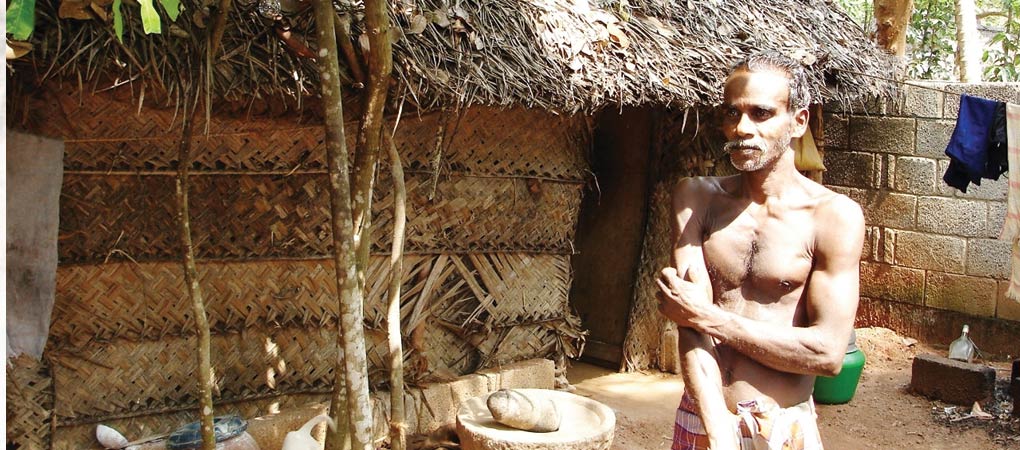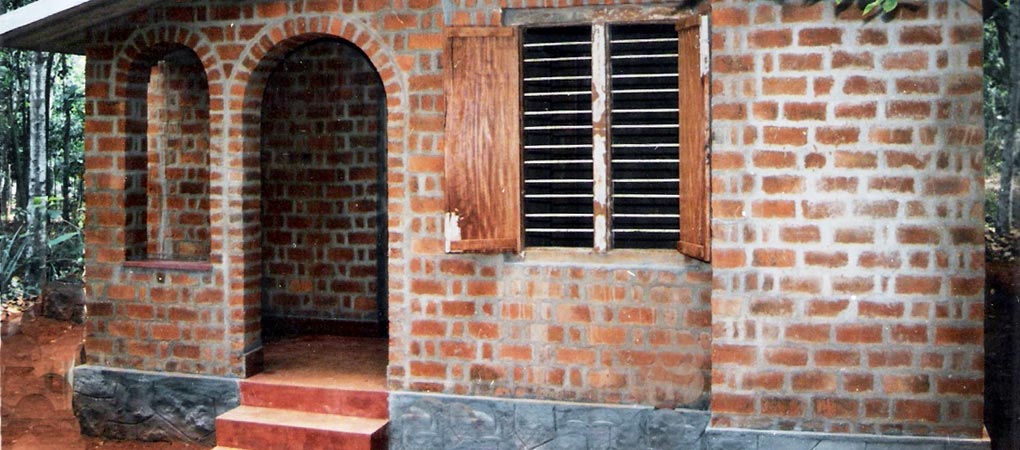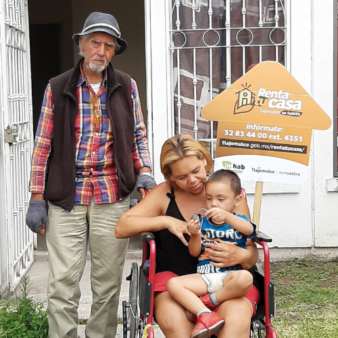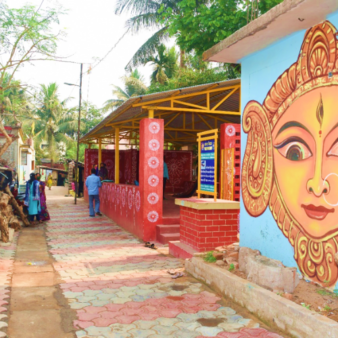Initiated by the Palmyrah Workers’ Development Society (PWDS), this project works to enable families to build their own secure, fire-resistant homes whilst improving their livelihoods. To date, 11,000 homes have been built through a participatory, mutual-help process and the housing movement continues to grow and extend itself through community solidarity and social networks and mainstream service linkages.
Project Description
Aims and Objectives
- To enable families to build their own secure homes whilst improving their livelihoods.
- Construction of fireproof, low-cost housing through a participatory, mutual help process.
- Training and capacity building.
- The use of appropriate technology in construction.
- The provision of affordable credit.
Palmyrah workers are rural artisans for whom the Palmyrah tree and its products are a source of livelihood opportunities. They collect sweet sap from the trees through a process known as ‘tapping’ and boil it at home to convert it into a solid sweet. The lengthy boiling process inside peoples’ thatched huts has led to a high incidence of fire-related accidents. Palmyrah workers lack economic power and have no status in society. The job is accident prone. They lead a dangerous life and suffer from high mortality rates.
Palmyrah workers live mainly in rural areas and have to migrate from home to neighbouring districts during tapping seasons to find daily wage employment. They live in huts made of mud or woven leaf walls and thatched roofs. These are very small, with barely enough room for the family let alone the large oven needed to process the Palmyrah products and the store of raw materials needed. Leaking water and fire are the main hazards, as well as the smoke-filled house, which leads to serious respiratory disease. A survey carried out by PWDS in 1987 showed that there were 22,000 Palmyrah tappers, in Kanyakumari district, of whom 80 per cent were living in sub-human conditions. It also indicated a very high level of demand for housing finance and services in the area. India has just over ten million Palmyrah trees, nearly half of which are in Tamil Nadu.

Initiated in 1990, this programme enables families to build their own secure, fire-resistant homes whilst improving their livelihoods. The Palmyrah workers are primary partners in the programme and their traditional wisdom and knowledge of housing is the basic technology used. Families are enabled to build their homes through an innovative funding scheme that involves a combination of community contributions, micro-credit and government subsidy. Community involvement and capacity building are central elements of the programme. Community centres are funded and built by local communities as a focus for community mobilisation and solidarity. They also provide training opportunities for young people and existing masons in low-cost and effective alternative building technologies. Other development programmes include awareness-raising for ecological consciousness, health, sanitation and education, as well as women’s empowerment, leadership and capacity building.
The local people were involved in planning, designing and implementing the shelter development programme. They were involved in the construction process of their own and their neighbours’ homes through the provision of free labour and moral support.
Funds from the mainstream financial providers, the Housing Development Finance Corporation (HDFC) and Housing and Urban Development Corporation (HUDCO) were used for provision of loan finance. PWDS established a community-based finance institution the Indian Association for Savings and Credit (IASC), to act as an intermediary to make funds more easily accessible, and the interest rate charged is nine per cent. No additional charge is made by PWDS. Grant aid from a German NGO (EED) is also received to help meet the costs. Individual house owners take full responsibility for the repayment of housing loans and any maintenance or improvements to their homes.
Technical guidance is provided by PWDS if needed. PWDS requires that the loanees collect initial building materials beforehand, such as sand, cement and tiles/asbestos. In addition, the foundation for the house must be laid and the building must be completed up to window level before the loan is released. Costs for this are met from savings made with IASC. The total loan amount is usually released in two to three instalments after various stages of the building are completed. Credit is mobilised from mainstream financial institutions. After the formation of IASC, it has extended 1,615 housing loans worth Rs 60.3 million (India Rupees), or US$1.34 million, i.e. US$830 per house. The other houses completed under the programme have accessed funds from HDFC or HUDCO.
With virtually 100 per cent loan repayment, the IASC is able to continue making loans. Twenty per cent of these are housing loans, the others being for economic, education, debt management and marriage purposes. A high repayment rate is achieved through the use of carefully established systems and procedures and, crucially, by having a collective accountability process where people know that if they default others will have to wait longer for their loans. In addition the loans are secured by land deeds. People value these documents and want to repay the loan as quickly as possible to have the document back in their ownership.
From the very beginning, there has been strong emphasis on people’s participation, including the identification and prioritisation of problems. The housing issues emerged only after discussions with the local people as to what they considered needed to be done. One of the key aspects of the programme is the emphasis on enabling the local community to organise itself and make all decisions regarding its housing and development programme. Local village-level associations, or mantrams, of approx. 20 members have been established to ensure genuine involvement. Although the primary purpose was savings management, the mantrams are the bodies that decide which members most urgently need houses and those who could wait for the next phase. These decisions were made on criteria established by the mantram, with no involvement of PWDS. Typical criteria include genuine housing need, regular attendance at meetings, good repayment records, assembly of building materials etc. Over time, PWDS has worked with these groups to sensitise them to development issues such as health, education, legal issues, poverty issues and livelihood skills.
Construction of community facilities was carried out as a collective activity with the cost of materials, labour and land being provided by the local community. The programme started in 1990 and is on-going. To date, eleven thousand homes have been completed.
Why is it innovative?
- Ensuring that professional services are available to the poor in the same variety and extent as they are for people that are on higher incomes, i.e. the involvement of mainstream financial institutions and the creation of teams of volunteer professionals.
- Provision of a life insurance scheme for the Palmyrah workers and housing (in response to a survey of housing workers and other needs).
- Use of the mantram organisations to take responsibility for the entire process from identifying the recipients, deciding on the manner of repayment, monitoring the construction and encouraging all members to be involved in the construction.
- Recognition that poor people can be an important client for a financial institution due to the large numbers involved and they do not need to be subsidised by NGOs or other development organisations/credit agencies.
What is the environmental impact?
Burnt bricks or hollow bricks were used for construction instead of timber which had been used previously and which is increasingly scarce. House design reduces the amount of timber used in internal fittings such as doorframes.
Improved water supply and sanitation is provided in the new houses improving the environment through reduction in the common practice of open defecation.
Is it financially sustainable?
There is a sustainable source of finance through the savings and credit institution created by PWDS. Repayment rates are virtually 100 per cent. The only source of default is the sudden death of a breadwinner. Even in these cases, the mantram is usually able to raise funds from the remaining members and repay the debt. Availability of affordable credit makes housing affordable in ways that were impossible before. All families in the mantram act as guarantor of the loan and help to ensure repayment on time.
Funding is obtained from mainstream financial agencies with poor people being seen as a reliable and important client base. Credit comes through specialist organisations set up by PWDS. The only collateral required is clear title to the land. Volunteer legal experts help obtain formal ownership documents to land for those that do not have them, thus making the land creditworthy. PWDS has invested some of the grant funds received on long-term deposit to generate interest which can help subsidise loan repayments.
New designs ensure that housing is more affordable since the power of the traditional masons and carpenters to insist on expensive traditional religious practices relating to construction is broken – including non-violation of standard plinth areas, roofing, layouts etc. This makes houses more affordable. Labour needed to build the houses is provided by mantram members and helps to reduce cost.
The programme has led to improved livelihoods for the Palmyrah workers and their children, both for those continuing with Palmyrah and those looking for alternative livelihoods (masons etc.).
What is the social impact?
Institutional building is an important part of the programme with mantrams of 20 members established in each village. There are also federations of mantrams at a regional level (mamantrams) with a general body and overall federation (peravai). The local mantrams are also able to solve local disputes, typically over land, through a collective process of dispute resolution. The larger bodies provide support for the local organisations and help lobby on issues faced by the Palmyrah workers. Local mantrams make decisions regarding the order in which housing should be built and who should receive their house first. Nineteen community buildings have been built by and for the community.
Improved educational opportunities for young people have helped to ensure that social inequalities are reduced. A range of educational and development programme activities have been introduced, including childcare and education, community health, housing development, project development, income generation, marketing support and resource mobilisation. Training is provided in group management and accounts to mantram members. Construction training has enabled some of the Palmyrah workers to become masons.
There has been a reduction in respiratory disease due to improved houses with the compulsory inclusion of a chimney to extract the smoke from boiling the Palmyrah products and a separate kitchen and living area. PWDS insisted that all houses be built with toilets in order to avoid the serious health hazards associated with the popular practice of open defecation.
Moving into a decent house has triggered a positive outlook on life and opened up possibilities for improved social status and active involvement in the local community. The chances of finding a bride and/or groom from a respectable family increases if you live in a decent home. Young people are now willing to bring friends back to the house.
The Shelter Programme has changed into a social movement with raised aspirations, not only for those directly benefiting but also for others who have learned from it.
Barriers
There was resistance by mainstream financial agencies who were concerned that people with very unstable incomes would be unable to repay the loan (classified as ‘sure defaulters’). This resistance was overcome with evidence of ten years of impeccable repayment records to the mantrams’ savings and credit associations and through convincing the agencies of the potential profitable business opportunity due to the huge volume of the clientele.
Regulations preventing the mainstream finance companies engaging directly with the Palmyrah workers were overcome by PWDS initially acting as an intermediary organisation and taking responsibility for collecting and making the payments and meeting any loans defaulted on. A separate micro-finance institution was created (IASC) to carry out this role.
Inability of the poorest workers to make monthly payments was overcome by extending the repayment period and using incentives to encourage repayment on time. This meant that the worker had to pay only 30 rupees a month which could be affordably saved from income at one rupee a day.
Lessons Learned
- The provision of shelter should be a process rather than a project in order to ensure the involvement and responsibility of local people in the development of their housing.
- No shelter development can succeed if people do not participate in the design, implementation and monitoring processes.
- No development project can be sustainable in the long term without the involvement of wider stakeholders such as the state and mainstream organisations.
- Successful development at scale requires a wider understanding of the development needs of the poor in society at large. The mainstreaming of the services of institutions and agencies from wider society is also required by extending it to the poorest sections of society.
- A mix of tradition and modernity was needed in the new house design to ensure its cultural acceptability.
Evaluation
A range of on-going monitoring activities are undertaken. These include assessing the demand for housing and housing loans, impact assessment, mantram involvement and the selection processes used. There are also regular reviews by the financing institutions.
Transfer
In 2000, the Reserve Bank of India brought out a notification on micro-finance and a housing loan for the poor based on PWDS’ work with HDFC. New housing loan products for low-income households are also being developed by local banks in Tamil Nadu.
PWDS has spread its activities to 24 districts in Tamil Nadu. Instead of setting up offices it has transferred its experiences to more than 50 partner NGOs, most of whom are working with low-income communities other than Palmyrah workers.
Shelter is no longer a major activity of PWDS (only 15 per cent of its income going on this) as it has become an independent activity supported by the organisations created by PWDS.
PWDS started with an initial pilot project of 100 houses and by the year 2005, 11,000 have been completed. The community-based finance institution it established operates in seven districts in Tamil Nadu with 79 different NGOs and has extended credit services to 2,400 self-help groups with a membership of more than 45,000 families. The 1,615 housing loans disbursed by IASC to date are valued at Rs 60.3 million (US$1.34 million).
The programme has spread throughout the southern half of Tamil Nadu where the vast majority of palmyrah workers in India are located.
Partnership
CBO. Local Community, NGO, Financial Institutions



